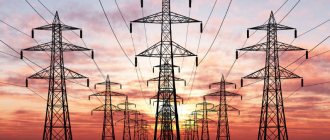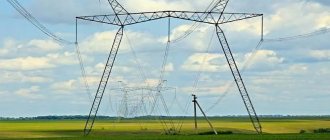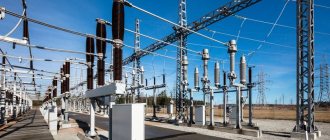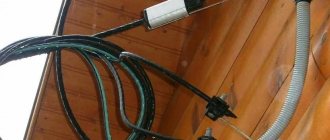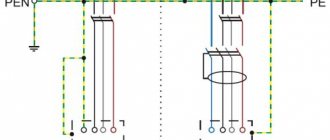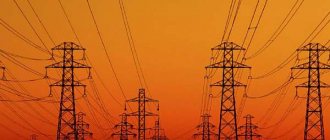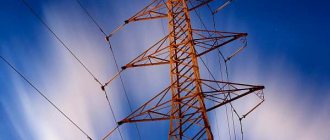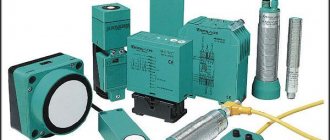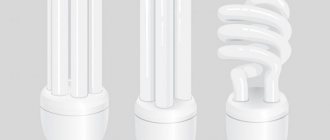When constructing buildings near the location of a high-voltage power line, a safe distance from the power line to a residential building must be maintained in accordance with SanPiN and SNiP standards. Limits are set by building standards and enforced by health inspectors. Fire safety rules are of no small importance for the distance between a residential building and power lines.
Electricity supply to cities
Harm to health
A power transmission line is a high-voltage power transmission line that is a major component of the energy system. The most common option is the overhead method of placing wires.
The health hazards of electromagnetic waves are very real, so there is no need to build buildings very close to power lines and overhead power line (OHL) supports. In order to protect people's health from the negative effects of electric fields, sanitary protection zones are created.
When purchasing housing, you should know what distance and how many meters there should be from a support or power line pole to the house.
Near the power plant
Possible ailments
Scientists have proven the negative impact of electric and magnetic fields of power lines on general condition and health. In the 60s, they carried out research work, during which a number of ailments of the following nature were noted in people living in apartments near power lines:
- high general fatigue;
- irritability;
- depressive states;
- frequent headaches;
- weak muscle tone;
- disturbances in the functioning of the cardiovascular system;
- memory problems;
- insomnia.
The list of physiological disorders can be continued endlessly. Foreign scientists have found that children living less than 150 meters from a power line are 2 times more likely to suffer from leukemia, and almost all of them have problems with the central nervous system.
Near the city
It has also been proven that sensitivity to electric and magnetic fields varies from person to person. Increased sensitivity to electrical radiation is called electrical allergy. Thus, one person will continuously feel the negative impact of power lines, while the other will not feel any ailments.
The risk group includes pregnant women, people suffering from allergies and nervous ailments, and children. The longer a person stays in the area of influence of electric fields, the more severe consequences this leads to. All vital systems suffer: immune, reproductive, hematological, nervous, endocrine, cardiac, vascular. Moreover, the risk of cancer increases sharply.
What is a transformer booth?
A transformer booth is a separate object, a metal kiosk or a brick or reinforced concrete building. Complete modular substations made of sandwich panels are also used. The set of equipment for such facilities includes:
- A step-down transformer that reduces the voltage coming from high-voltage lines to the limits required by end consumers (220, 380, 630 V).
- Devices for connecting inputs and outputs on the high and low voltage side.
- Automatic protective shutdown in the event of a short circuit and other emergency situations.
- Disconnectors and other equipment control devices.
- Protective grounding system.
A standard set typical for power substations and distribution equipment.
When tension is dangerous
Voltage in power lines can be dangerous or harmless. There is a connection between the range of the electric field generated by a power line and the power of this line.
Power line support
These quantities are directly proportional. To calculate the voltage, you need to take into account that the total number of wires in the connecting phase of one phase varies. The voltage is:
- 2 wires – 330 kV;
- 3 wires – 500 kV;
- the presence of 4 wires indicates a voltage of 750 kV.
In order to protect people from negative side effects, PUE (Electrical Installation Rules) standards were prescribed for the distance from home to power lines, which should be followed during the construction of a residential building and the construction of non-residential public buildings. When purchasing a plot near a power line, the permitted distance must be observed.
Source of income and object of subculture
Abandoned transformer boxes are the object of increased attention from scrap metal collectors. And this is not surprising - after all, in the “working heart” of each substation - the transformer - copper wire is used to make windings, and copper is a material, the demand and prices for which when accepted by Tsvetmet are always at a high level. This practice of earning money is deadly! There have been repeated cases of serious electrocution of copper hunters in transformer substations.
However, many are still tormented by the question of how much copper can be obtained this way? And there is no definite answer to it; everything will depend on the power and type of transformer. Copper windings, as a rule, are used in two-winding transformers with a power from 25,000 to 80,000 kVA and in three-winding transformers, with a power from 6,300 to 80,000 kVA, and the higher this value, the more of this non-ferrous metal is used.
Electrical substation buildings have now received a much more useful and safe use with the advent of the street subculture. Many of them can easily be classified as fascinating art objects. The walls become colorful paintings by experienced artists and novice street painters.
However, it should be understood that before you start applying drawings on transformer booths, you need to obtain the appropriate permissions from the owners of these objects and be sure to undergo safety training. Artists must also comply with the mandatory rule - not to paint over safety warning signs, as well as dispatcher names.
Safe distance from power lines to residential areas
The standards prescribe a safe distance from power lines when sanitary protection zones must be created along it, the type of which is closely related to the degree of network voltage.
Dimensions of the security zone and its distance from the power line support
When constructing buildings in close proximity to a power line, the following distance is provided:
- 0.4 kV (380 V) – 2 m;
- 6–10 kV – 10 m;
- 20 kV – 10 m;
- 35 kV – 15 m;
- 110 kV – 20 m;
- interval from 150 to 220 kV – 25 m;
- 330, 400, 500 kV – 30 m;
- 750 kV – 40 m;
- 1150 kV – 55 m.
An overhead line (overhead line) with a voltage of 6 kV and even 10 kV is considered safe for humans according to SanPiN 2971-84. This also complies with European standards.
Secured territory
To more correctly determine the permissible boundaries, a conditional perpendicular projection is made onto the surface of the earth from the side wires of the power line. It is better to multiply the presented voltage indicators by 10: this will increase the degree of security.
A minimum distance of 100 meters will be completely safe. During bad weather, an additional amount of oppositely charged ions is released into the atmosphere, and this leads to the growth of the electromagnetic field and its entry into safe areas.
Electromagnetic wave propagation diagram
Thus, the higher the voltage of the power line, the further away the residential building should be. There should be no garages, fences or other structures in the sanitary protection zone, as well as near the supports. Moreover, no trees are planted in these areas.
Degrees of fire resistance of structures
The degree of fire resistance is also prescribed at the legislative level. There are five types of equipment depending on its fire resistance. In this case, the possibility of placement is calculated only for buildings in which people live on a permanent basis or spend their leisure time frequently (clinics and places of commerce, cinemas and shops). So, if the fire resistance class is:
- 1, 2 or 3, then the minimum distance is 3 meters;
- 4 or 5, then from 5 meters.
This is a calculation based on only 1 power indicator. The fire safety indicator is a combination of distance and weight. If the structure weighs at least 60 kilograms, then the distance for degrees 1 and 2 will be 16, 3 - 20, 4 and 5 - 24 m.
Formation of the indicator
The indicator is established by looking at the starting point of the process to its most active state. The degree of fire resistance is formed from knowledge about:
- the density of the material used and its strength relative to ignition;
- loss or preservation of load-bearing structures of their type;
- thermal insulation capacity, that is, how quickly heat will spread across the surface.
Transformer booths made of reinforced concrete are considered the best in terms of fire resistance, and metal ones are considered the worst.
Varieties and their characteristics
Buildings are assigned levels depending on their indicators. So, degree:
- concrete and reinforced concrete;
- concrete and reinforced concrete plus steel elements;
- options with stone and plaster, slabs;
- with sheets of metal;
- arbitrary.
What additional methods of protection are there?
To increase protection from the harmful effects of fields generated by power lines, additional protection options are provided. These include:
- Shielding devices for voltages from 10 kV.
- Roofs made from metal tiles or corrugated sheets should be grounded. The roof is grounded only if the distance from it to the power lines is small.
- The presence of reinforcing mesh - the kind that is laid in reinforced concrete walls.
At present, the harmful effects of power lines on human health have not been officially confirmed. Such studies have not been conducted in Russia. But this does not mean that the problem does not exist.
Possible damage zone in an accident
According to the observations of foreign scientists, a huge number of people who live or work in close proximity to high-voltage structures experience their negative influence, they often feel unwell. In addition, the risk of nervous ailments and the development of cancer increases.
FAQ
Is the proximity of power lines to a dacha or garden plot critical?
If a dacha, garden house or any other buildings are not used for permanent residence, then doing anything to protect power lines from the magnetic field does not make sense. Short-term exposure to radiation can cause headaches and dizziness in people with a particularly sensitive nervous system. Only constant stay in the field for a long period of time is critical.
What could be underneath the transmission lines?
No objects can be located under powerful power lines, with the exception of buildings that have been assigned the first or second fire resistance class.
Sanitary protection zones
Security zones near power lines are fixed in accordance with the requirements of Rostechnadzor. The boundaries of protected areas are marked in the State Cadastre. When purchasing land or housing, you need to carefully study the cadastral documentation in order to subsequently avoid unpleasant factors.
Marking of the territory is carried out using signs installed on the supporting structures of the power line at a distance of 250 meters from each other. The signs indicate the size of the zone, the power of the line in kW and the contact information of the owner of the power line.
Pole options
On the territory of the sanitary protection zone it is prohibited:
- launch foreign objects, for example, kites or flying objects towards power lines;
- climb onto supporting structures;
- block the passage and access to supporting structures;
- drain corrosive liquids or substances that promote corrosion into the ground, since they negatively affect the supports;
- organize landfills;
- plant or cut down bushes and trees;
- carry out blasting operations;
- use agricultural machinery higher than 4.5 meters;
- make fires.
In these territories it is prohibited to organize events requiring the participation of a large number of people.
Scheme of a security zone along an overhead power line
Sports and children's playgrounds cannot be installed there either. Thus, the sanitary protection zone cannot be used to its maximum. Compliance with all rules is mandatory.
